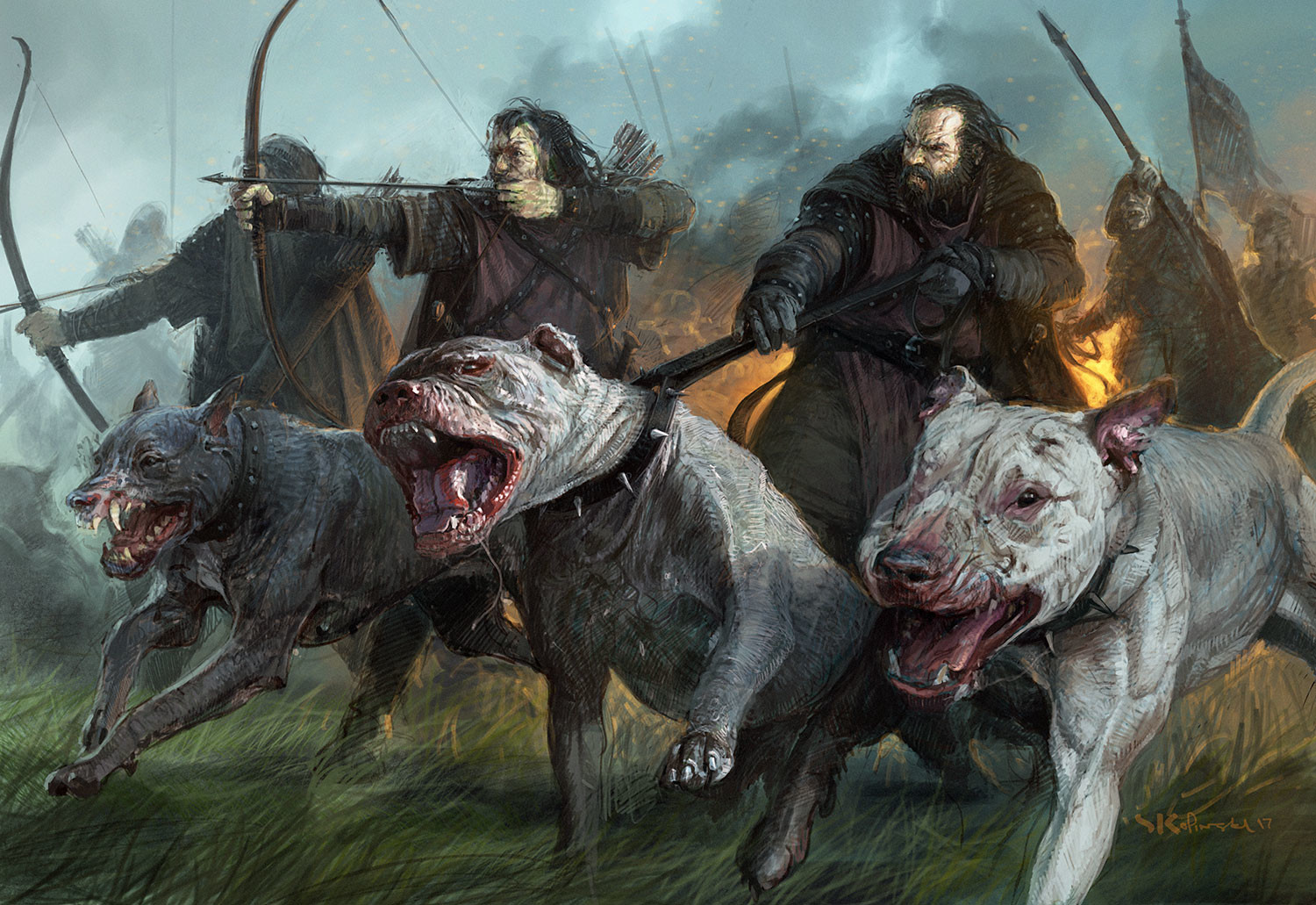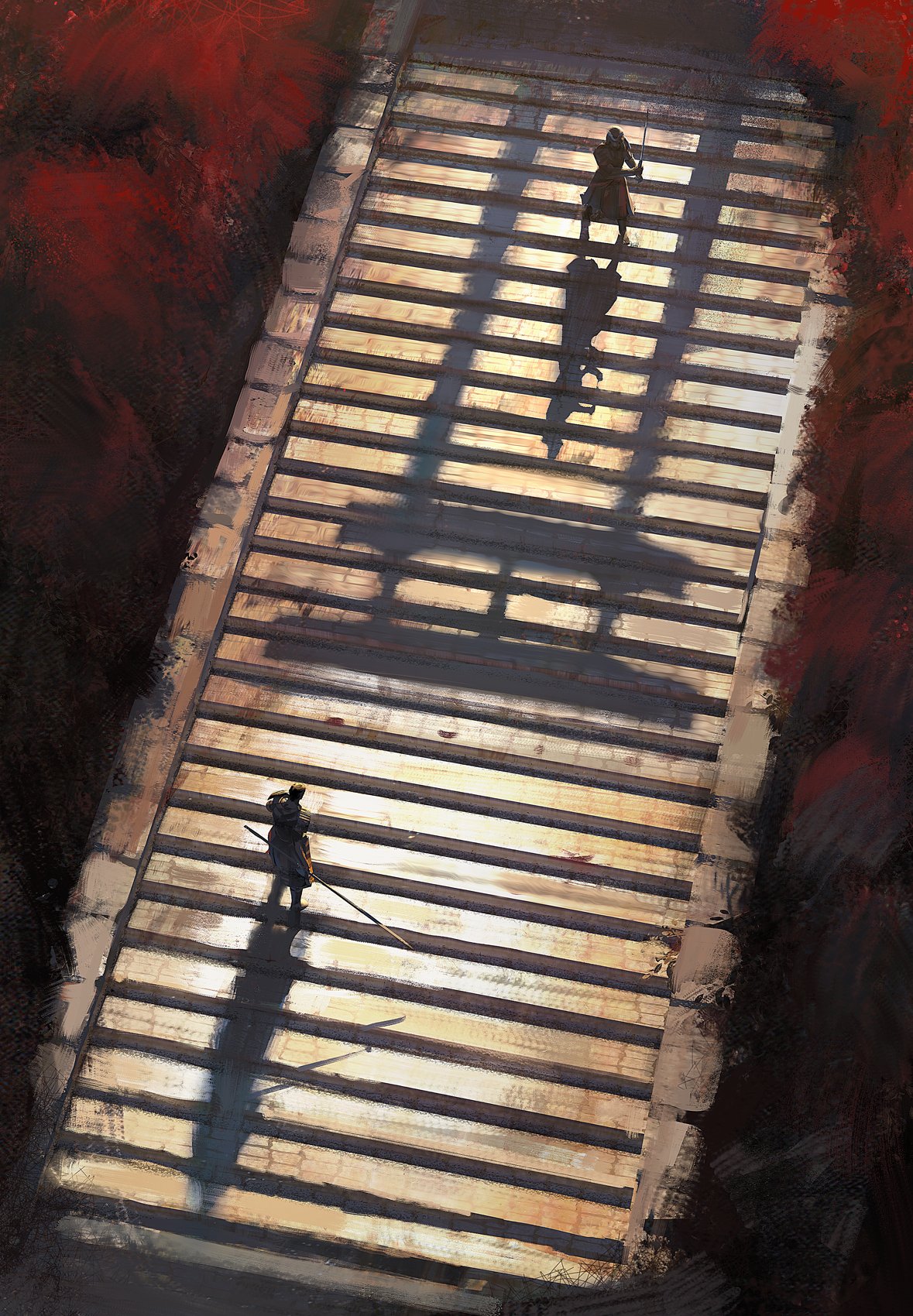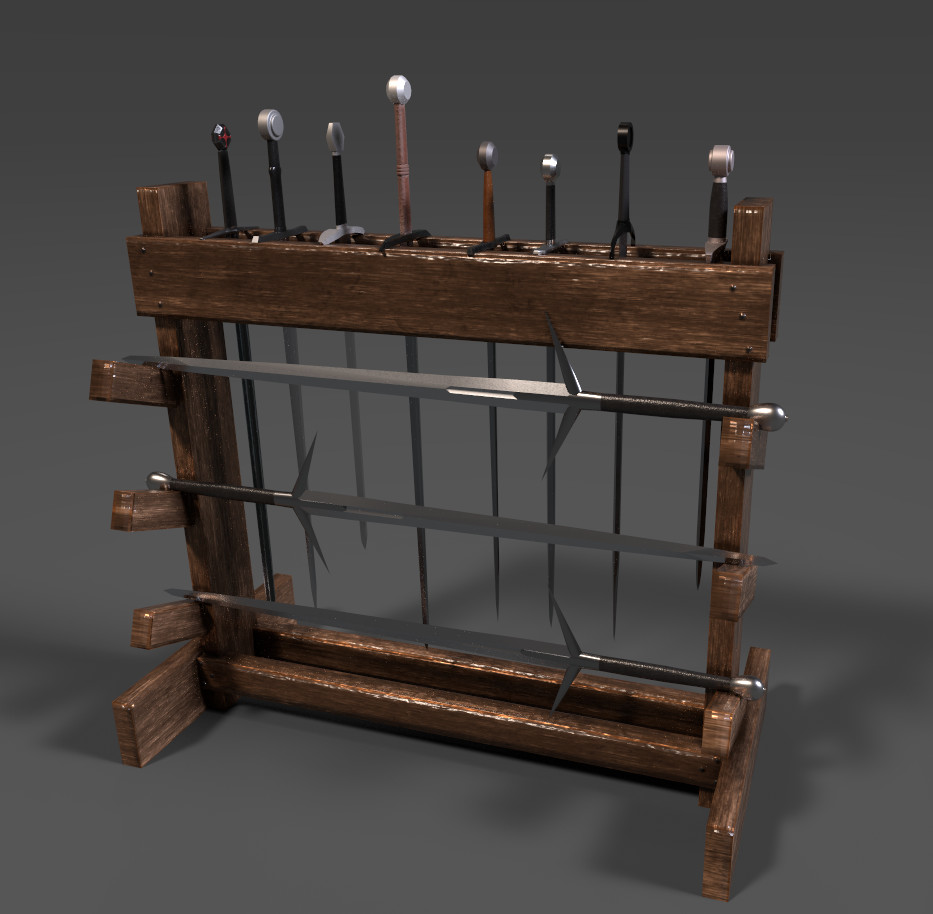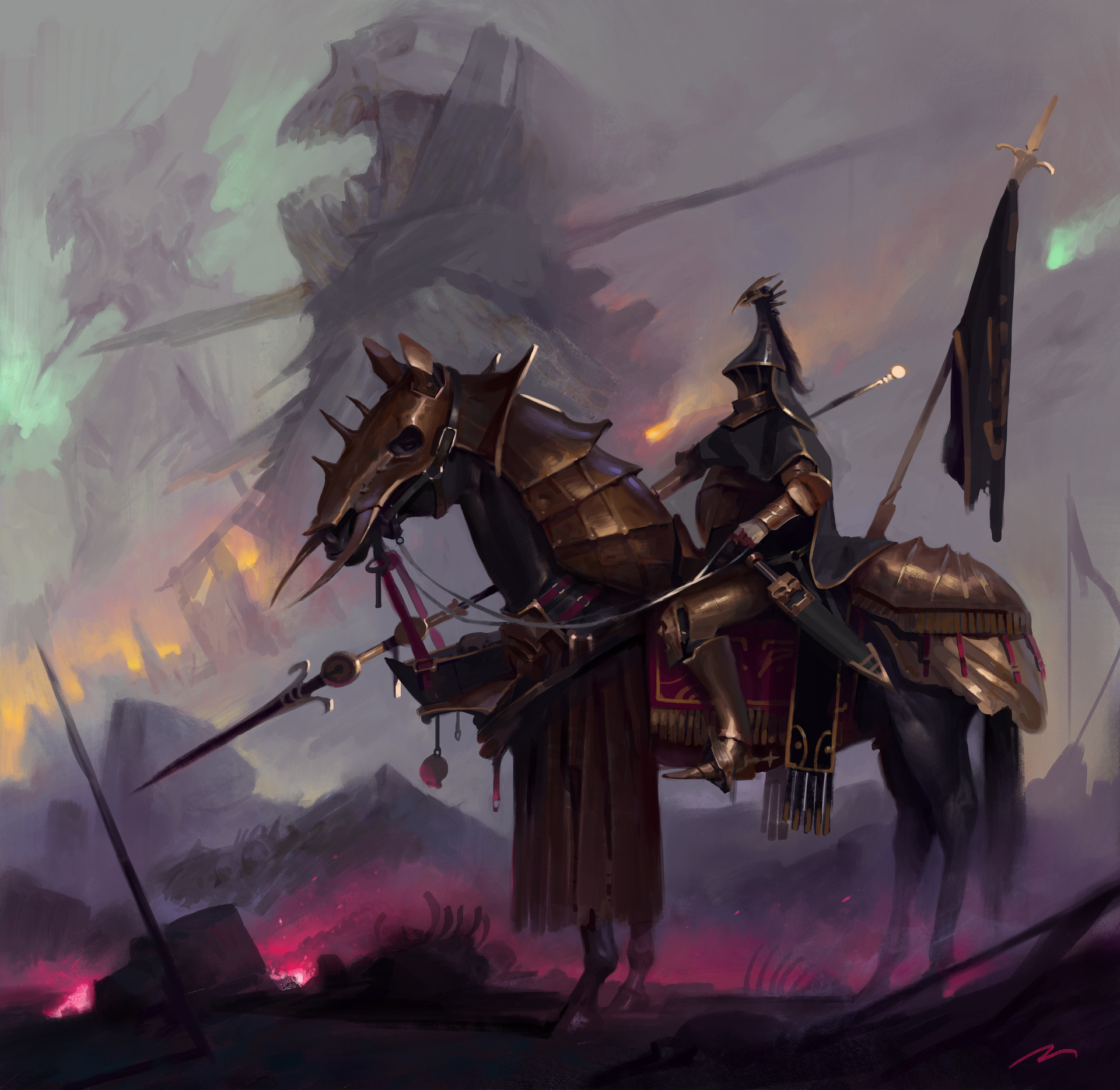I need this combat to achieve the following things for my table and my players:
- Be quick and exciting.
- Have some amount of tactical depth, but not enough to dominate the scene.
- Have potential for narrative description.
- Include some kind of slight simulation of IRL combat.
 |
| By Francesco Lorenzetti |
The Blood Game
The Blood Game begins when at least two creatures engage in violence with one another.
The space these creatures fight in is called the Melee. The Melee extends 10 feet beyond all creatures. While in the Melee, every participant can attack any other participant. There are no "moves" here; the Melee is a roiling chaos, and bodies are shuffled in and out. A creature can forgo its turn while in the Melee to exit it.
Inside the Melee/Melee Round
While inside the Melee, you are trying to kill or subdue any and all enemies. You do this through attack rolls, which must be with a melee weapon (or natural weapon), as no ranged weapon can be logically used here. Spells cannot be cast either, as they will always be interrupted.
The referee will go around the table, asking everyone who it is that they are attacking. No one rolls. Once everyone has decided, the referee decides who their monsters will attack. Alternatively, someone with a special ability, like dragon's breath or a medusae's stare, can use the ability on a target (or group of targets) instead of rolling.
Everyone then rolls at once. Roll the attack roll (1d20, compare to thac0), and the damage roll (1d6). All attacks are resolved at once. Someone can also attempt to grapple.
As per OD&D rules, the grappler and the grappled roll d6 equal to their HD. If the grappler wins, they grapple their target, preventing them from leaving the melee or attacking. If the grappled wins, the grappler is stunned next round and cannot act, and can be thrown outside the melee if the grappler wishes. Record the grappler's total roll. A grapple can be contested instead of an attack, leading to a rerolling of d6 against that total to see if the grappled escapes.
If anyone falls to 0 hit points, they are defeated. Their defeater decides then and there whether to take their life or to show mercy. This ends the Melee Round and begins the Outside Round.
 |
| By Stefan Kopinski |
Outside the Melee/Outside Round
Creatures outside of the melee take their turns after every Melee round.
The referee, just like in the Melee round, goes around the table, asking the players what they want to do. This is generally using a ranged weapon, entering the Melee (but making no attack this round), casting a spell, or doing something else entirely.
Firing a ranged weapon or spell into the Melee is dangerous. When the referee has everyone roll for their actions (including creatures saving from spells inside the melee), those firing ranged attacks roll 2d6. If they miss, the lower of the d6 hit a target of the referee's choice.
Just like above, if anyone falls to 0 hit points, they are defeated. However, only a participant of the Melee round can decide to kill or spare (instead of making an attack roll or using a special ability) a defeated combatant.
A creature can flee the Blood Game if they are Outside the Melee. If they do so, another creature Outside the Melee can chase them instead of attacking, thus coward inside the Blood Game.
Once this is done, the next Melee Round begins.
 |
| The below rules make duels quick, bloody |
Attacking Those Outside the Melee
A creature can leave the Melee to attack someone outside of it. When this happens, the attacker and the attacked have a special Duel Round that takes place between the Melee Round and the Outside Round.
During the Duel Round, ranged weapons other than crossbows or loaded firearms cannot be used, but they cannot be reloaded. Attacks are resolved at the same time, as in the Melee Round.
If at least 1 other creature joins this duel, treat the duel as a part of the original Melee Round, which in turn expands the space of the Melee significantly.
 |
| By Donald Artz |
Variable Weapons
I use flat weapon damage, as the aesthetic of d6 damage matching d6 HD is a good bit of design.
To make weapon choice matters, I attach little mechanics to each weapon type. This isn't needed, but can be a fun way to spice up games.
- Daggers roll max damage on subdued or grappled targets.
- Polearms allow Outsiders to attack the melee without needing a ranged weapon.
- Great weapons (great axe, great sword, maul) cleave, dealing excess damage to another target of the attacker's choice.
- Hammers deal 1 damage on a miss.
- Staves push targets out of the Melee on a 1 or 6 damage roll.
- Whips disarm a target on a 6 damage roll.
- Warpicks destroy a shield on a 6 damage roll.
- Swords reroll damage rolls of a 1, but must take the new result.
- Firearms double the total damage roll. Must be reloaded after 1, 6, or 10 shots, depending on the firearm. Reloading replaces attacking.
- Crossbows roll with advantage (roll 2d20 and take the better result) and must be reloaded after every shot.
- Bows can obviously be fired off at range.
Let me know what weapon types I'm missing (and suggested ideas for them) in the comments, please!
Note on Duel-Wielding
If you have a weapon in your off hand that isn't great or a staff or polearm, make another attack roll. For the damage, roll 2d6 and take the lower amount for this roll.
Note on Edge Cases
Things like flipping a rock onto somebody, or pushing someone off of something, are edge cases that should be considered. Some guidelines:
- Anytime a creature tries to forcibly move another and is not grappling them just treat the shove or what have you as a grapple roll.
- If a creature does something like trying to flip a rock onto another, you can either have it be resolved as a stat check, or an attack roll with disadvantage (roll 2d20 and take the worse result), or maybe a simple save vs Breath Weapon. Damage is 3d6. If the attack roll misses, the referee chooses a random target that takes the damage.
 |
| By Mauro Belfiore |
For Wars
The Blood Game can be used for Mass Combat as well. Follow the following guidelines;
- Determine army size, to the nearest unit of 10.
- Divide armies into units of 10, 100, 500, 5,000, or 10,000.
- Size of the unit determines its HD. 1d6 for 10, 2d6 for 100, 4d6 for 500, and doubling to a max of 16d6.
- Units deal d6 damage on an attack, as always.
- Units are equipped with equipped as infantry, cavalry, ranged, or spell.
- Infantry is standard Melee Round units.
- Cavalry kicks a unit out of the Melee on a 5 or 6.
- Ranged is standard Outside Round units.
- Spell are standard (spellcasting) Outside Round units.
- Units that fall to 0 HP cannot be spared. Instead, they break rank and flee.
- Players should roll for whatever units they claim at the START of the war.
- Grappling Units is reflavored as suppressing a unit.
- Units can be in the Melee or Outside the Melee, as normal.
- The Melee takes up a space between 1-10 miles, as per referee decision.
- Duels happen between champions of the army. These Duel Rounds cannot become Melees.
- A new round, described below, is offered: the Warlord Round.
- An army that loses rolls a d10 and loses that percentage of men.
- A winning army can chase the losers. If they do so, the loser rolls another d10 and adds that to the percentage of men lost. So if the losers roll a 6 and then a 2, they have lost 80% of their men total.
- Naturally, units need to be reformed after an army loses.
The Warlord Round
PCs can hire or act as warlords for their armies.
After the Melee and Outside Rounds resolve, the Warlord Round begins.
Warlords decide on a tactic they want to try. This is narrative deciding if you want to try to flank, pincer, or any other stratagem. War is a game of chance as much as it is of intelligence, however. Both sides have their warlords roll under Intelligence or Wisdom (or Savvy, if you're using my stat array) and count successes. Each success adds 1d6 damage to a single unit's attack roll during the Melee or Outside Rounds.
After the successes are counted, the Warlord Round ends and the next Melee Round begins.
Warlords can be engaged by a unit Outside the Melee. Engaged Warlords do not receive a Warlord Round, and are considered a unit of 10 that are Outside the Melee.
Units Outside the Melee can forfeit their attacks to defend Warlords. Doing so prevents them from being engaged.
Note: This takes some player skill out of Mass Combat, but that's fine for me, as Mass Combat is a rare thing usually and I'm really just trying to get some decent results instead of playing a full on wargame here
Hmm... (pun intended), this seems interesting, but perhaps a little overly complicated. Does it actually play faster / feel more compelling than regular d&d combat? If you haven't done so, I would recommend you check out Tunnels & Trolls. TNT handles combat in a somewhat similar way to this, but perhaps comes closer to what I think you're trying to do.
ReplyDeleteSome of this was inspired by T&T.
DeleteI plan on playtesting it soon. I don't think its very complicated, just that the information is presented in a new way, so information transmission would need to be worked on when making this a final product.
That's fair, it may just be something I'd need to experience first hand. In any case I do think it's a cool idea, sorry if that came off too negative.
DeleteI agree with maxcan, there's a lot of room for simplifying here that doesn't use any of the flavor you are aiming for, id look at least combining attack and damage rolls to speed things along (follows along with your focus on speeding up combat). Good idea on mass combat, I like the warlord system, though I may just combine 500/5000 to 1000 myself.
ReplyDeleteI think there might be some space to condense things too! Currently going through for the playtest to see where I can condense, etc. Any suggestions beyond the damage roll combinations?
DeleteIf you have advantage/disadvantage as a mechanic id try to mold any sub-system rules (like weapon types, etc) around that just for easy of memory.
DeleteAlso, personally, the Duel round feels extraneous, the gain you get from increased realism I think would get counteracted by the slowdown from the rule getting used. If d6s are already being used elsewhere, it might be a good idea to have ranges governed the same way instead of in base 10/100/whatever.
Of course, I'm not trying to say these are the perfect solutions for you haha feel free to take/leave what you want. Good work regardless
5 years ago I had warts, I was treated with some liquid applied to the warts they continued to grow and spread... The next 2 doctors did laser surgery to remove them. 1 year after the surgery, they grew back close to where the 1st ones were' so I was finally told it was hpv. I have had it for very long time, I contract it from my cheated boyfriend and I found out he was also infected and I end up the relationship between us. the warts was so embarrasses because it started spreading all over I have be dealing with this things for very long time the last treatment I take was About 2 years ago I applied natural treatment from Dr onokun herbal cure, a week after applying the treatment all the warts was gone. it's now 2 years and some months I don't have single wart or any symptoms of hpv. wow"" it's great, Dr onokun has finally cured me. Anyone living with hpv contact Dr onokun for natural treatment.
ReplyDeleteHis email address: dronokunherbalcure@gmail.com